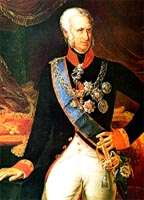Treaty of Florence
The Treaty of Florence (28 March 1801), which followed the Armistice of Foligno (9 February 1801), brought to an end the war between the French Republic and the Kingdom of Naples, one of the Wars of the French Revolution. Forced by the French military presence, Naples ceded some territories in the Tyrrhenian sea and accepted French garrisons to their ports on the Adriatic sea. All Neapolitan harbours were closed to British and Ottoman vessels.
Napoleon was relatively lenient to the defenseless kingdom of Naples thanks to his need to appease Tsar Paul I of Russia and its allies of the League of Neutrals. The Tsar, who was assassinated less than a week before the signing of the treaty, was concerned with the French advance in Italy and had decided to support the King of Naples. The First Consul, wanting to attract the Tsar to his side in the strife in Europe, was forced to allow Ferdinand IV remaining on the throne, albeit now a vassal of Napoleonic France.
Context
.png)
In the early nineteenth century France, with Napoleon in charge, was at war against the Second Coalition formed by the Holy Roman Empire, Great Britain, Portugal, the kingdom of Naples, Russia and the Ottoman Empire. Spain and France remained a military alliance since the signing of the Treaty of San Ildefonso in 1796.

After the victories of Napoleon's army in the campaign of 1800 in Marengo, Höchstädt and Hohenlinden, on 9 February 1801 the Holy Roman Empire made peace with France by the Treaty of Lunéville. Naples, that until Marengo had help from the Holy Roman Empire, was at the mercy of the powerful French army.
Ferdinand IV, King of Naples and (III of) Sicily, was the brother of Charles IV of Spain, but their relationship was no obstacle to oppose the Franco-Spanish alliance. The influence of his wife, Queen Maria Carolina of Austria, of the Austrian royal family, led to the alignment of Naples with the Second Coalition and the Holy Roman Empire. Maria Carolina was the sister of Marie Antoinette, queen consort of France. The crown prince of Naples, Francis, was married to the Archduchess of Austria Maria Clementina, daughter of Emperor Leopold II.
Agreements
Armistice of Foligno
With the advance of the French army under General Murat, Count Roger de Damas, in command of the Neapolitan troops, sent Colonel Micheroux to negotiate an armistice for one month. With this preliminary armistice, the final armistice was signed in Foligno on 9 February a few days later.
Treaty of Florence
The final treaty was signed on 28 March in Florence with the mediation of the Russian general Lewaschef sent by the Tsar Paul I at the request of Maria Carolina. The main points of the agreement were:
- King Ferdinand to be restored to the Neapolitan throne.
- Naples to cede the State of Presidi with their portion of the island of Elba, Porto Longone, and the independent principality of Piombino to France.
- The Neapolitan troops to withdraw from the Papal States.
- Neapolitan ports to be closed to British and Ottoman ships.
- Trading privileges to be granted to France.
- Naples to allow the stationing of French troops, with Neapolitan financial support, on Neapolitan territory for a year: the city of Pescara and the province of Terra d'Otranto, including the cities of Brindisi and Otranto.
- Release of prisoners of war on both sides, including the French scientist Gratet de Dolomieu, and Neapolitan amnesty to imprisoned and exiled Jacobins.
- The statue Athena of Velletri to be returned to France.
Effect and aftermath
The principality of Piombino and the State of Presidi would be ceded to the Grand Duchy of Tuscany and transferred to the Spanish infante Louis Francis of Bourbon-Parma, in exchange for the Spanish colony of Louisiana, as agreed in the Treaty of San Ildefonso of 1800. In May 1801 the French general Soult with 10,000 troops occupied the ports of Otranto, Taranto (temporarily) and Brindisi, to facilitate communications with the French army in Egypt. Following the signing of peace between France and Russia in October 1801, French troops temporarily evacuate the Neapolitan territory, again to occupy the country in 1803 against the threat from the British fleet.
With the treaty of Florence, together with the treaties of Lunéville and Badajoz and the Concordat with the pope and culminating in 1802 with the signing of the Peace of Amiens, there was peace in Europe until 1805, when hostilities would resume in the French war against the Third Coalition.